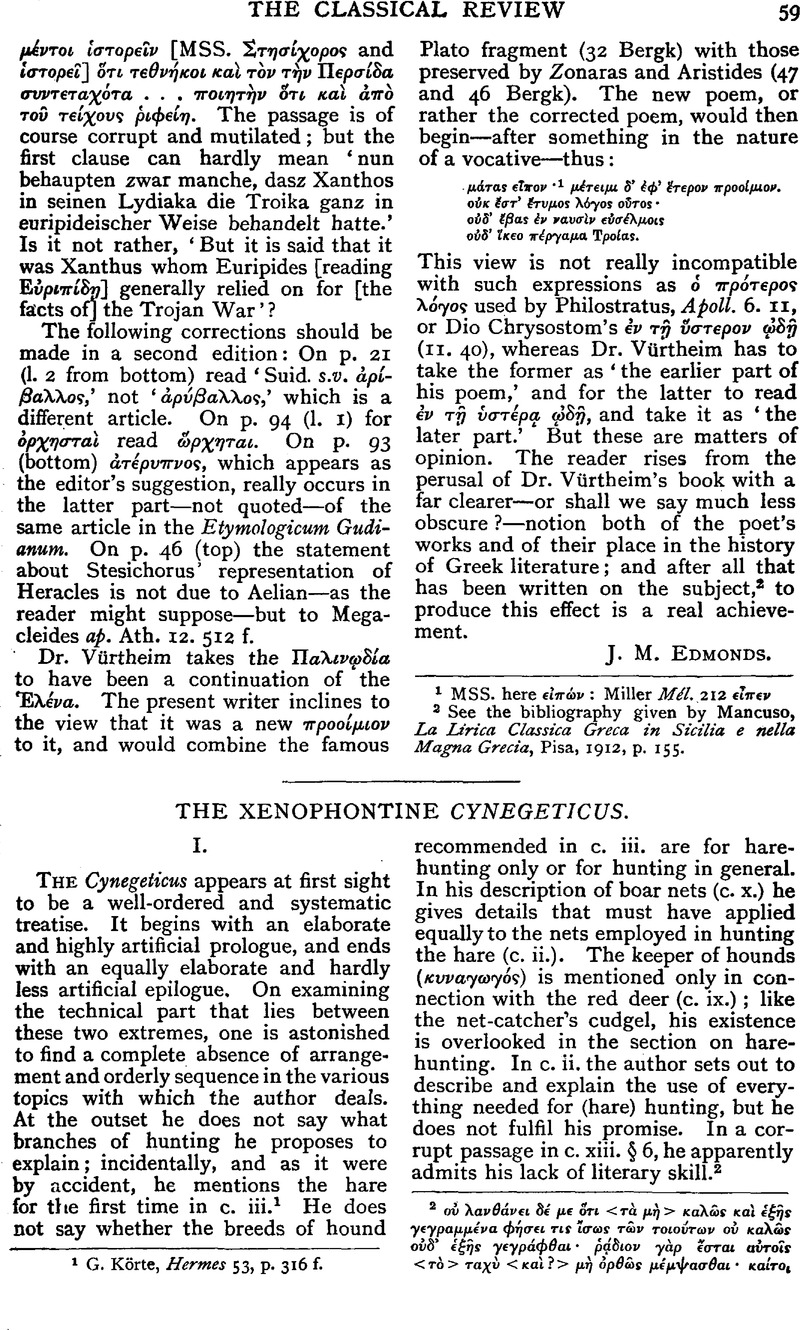No CrossRef data available.
Article contents
The Xenophontine Cynegeticus
Published online by Cambridge University Press: 27 October 2009
Abstract

- Type
- Review Article
- Information
- Copyright
- Copyright © The Classical Association 1922
References
page 59 note 1 Körte, G., Hermes 53, p. 316 f.Google Scholar
page 59 note 2  . It cannot be maintained after Radermacher's exhaustive studies that this chapter is not by the man who wrote the rest of the treatise.
. It cannot be maintained after Radermacher's exhaustive studies that this chapter is not by the man who wrote the rest of the treatise.
page 60 note 1 ![]() . Then, after a Xenophontine remark, he goes on:
. Then, after a Xenophontine remark, he goes on: ![]() , etc. The transition is so abrupt that we may suspect the loss or deletion of a sentence before χρ⋯.
, etc. The transition is so abrupt that we may suspect the loss or deletion of a sentence before χρ⋯.
page 60 note 2 This was perceived by Otto Manns, whose monographs, Uber die Jagd bei den Greichen (1888–90), form the basis of all subsequent treatment. But Manns goes too far when he puts together all the details given about all the nets, and evolves a description of a hunting net that applies to all kinds, maintaining that there was no difference in principle, but only in size and strength. He therefore thinks that ⋯ν⋯δια and δ⋯κτυα, as well as ἄρκυες, were ‘fall nets.’ The author of the article Jagd in Pauly-Wissowa and Dr. Enk in his edition of Grattius do not commit themselves to this view.
page 60 note 3 So Pollux seems to understand; and of coarse we compare the cassis in Grattius.
page 60 note 4 Contrast c. x. 7, of the boar net, ![]() .
.
page 60 note 5 According to Manns 5 feet, as recommended for road nets and hayes.
page 60 note 6 ![]() , ii. § 4. This is the correct version. ὐφέισθωσαν is due to a lacuna, which was filled by a comparison with c. x. § 2.
, ii. § 4. This is the correct version. ὐφέισθωσαν is due to a lacuna, which was filled by a comparison with c. x. § 2.
The author does not say how the περ⋯δρομοι of road nets and hayes were made fast.
page 61 note 1 ![]() .
.
page 61 note 2 Cf. ii. 7 ![]() .
.
page 61 note 3 vi. 10 φυλαττ⋯τω δ᾽ ⋯κπɛριὠν(so A, i.e. ⋯κπɛριὠν with Aeolic elision), ⋯⋯ν δ᾽ ⋯κκλ⋯νητ⋯ν στοῖχον (so Pierleoni: τ⋯ν στ⋯χον A: στ⋯χος BM).
page 62 note 1 Manns takes the meaning to be that the ends of the top ropes are to be run through the rings down the sides so as to fasten the nets; but ![]() in this bewildering passage refers to both top and bottom ropes.
in this bewildering passage refers to both top and bottom ropes.
page 62 note 2 Pollux v. 36 mentions ![]() . In the passage cited above ὐπ⋯ δ᾽ ⋯κ⋯στης should be corrected to ὐπ⋯ δ᾽ ⋯κ⋯στην: cf.xii. 13 ὐποβ⋯λλονται AB, ὐπɛρβ⋯λωνται M.
. In the passage cited above ὐπ⋯ δ᾽ ⋯κ⋯στης should be corrected to ὐπ⋯ δ᾽ ⋯κ⋯στην: cf.xii. 13 ὐποβ⋯λλονται AB, ὐπɛρβ⋯λωνται M.
page 62 note 3 In the Oxford text I have given οὐκ ἰσχυρα⋯ for συνὐχονται.
page 62 note 4 Especially by Hartman.
page 63 note 1 In vi. 17 ![]() etc., A omits ἰὼ κακ⋯ς. Lenz's ἰὡ κακ⋯ς is not right: we must read either ἰὼ κ⋯νες again with Dindorf, or ἰὡ καλ⋯ς.
etc., A omits ἰὼ κακ⋯ς. Lenz's ἰὡ κακ⋯ς is not right: we must read either ἰὼ κ⋯νες again with Dindorf, or ἰὡ καλ⋯ς.


